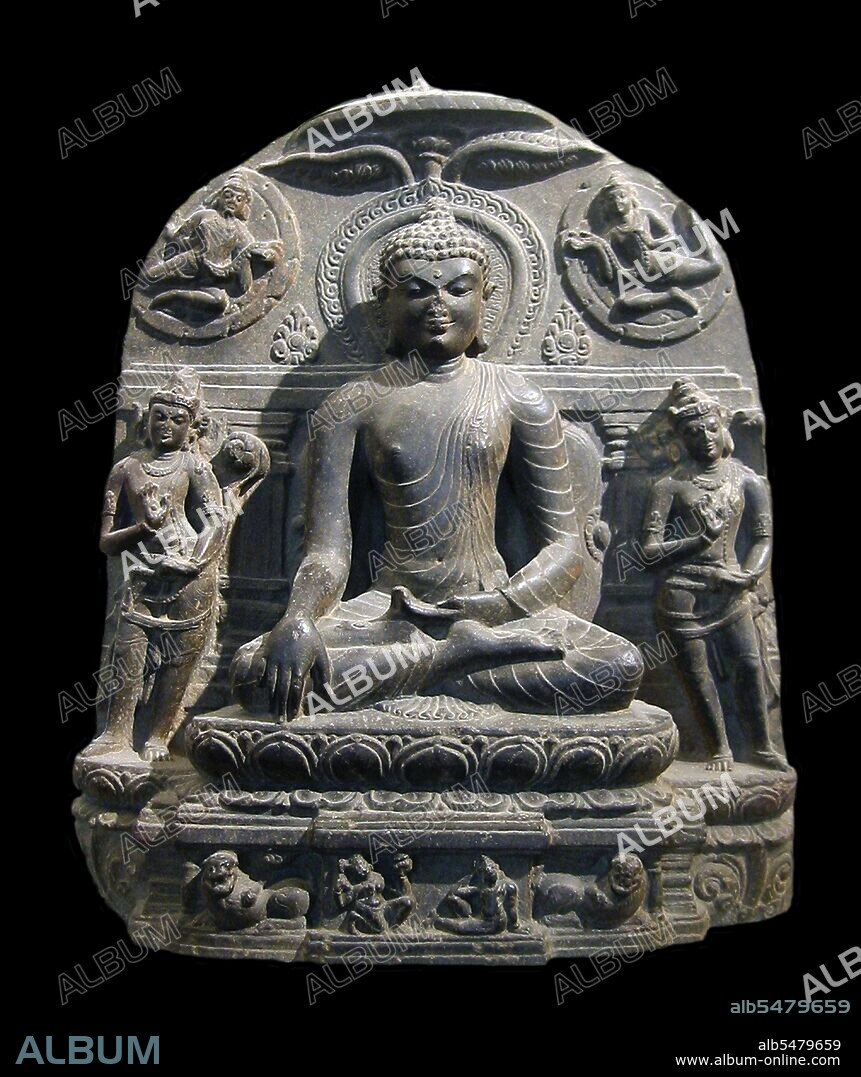alb5479659
India-Bangladesh: Buddha in the Attitude of Victory over Mara mudra ('calling the earth to witness') flanked by two bodhisattva. Mahayana tradition, Pala Dynasty, Bengal,11th century

|
Add to another lightbox |
|
Add to another lightbox |



Title:
India-Bangladesh: Buddha in the Attitude of Victory over Mara mudra ('calling the earth to witness') flanked by two bodhisattva. Mahayana tradition, Pala Dynasty, Bengal,11th century
Caption:
The Pala Empire, one of the major middle kingdoms of India, existed from 750–1174 CE. It was ruled by a Buddhist dynasty from Bengal in the eastern region of the Indian subcontinent, all the rulers bearing names ending with the suffix Pala (Modern Bengali: ??? pal), which means protector. The Palas were often described by opponents as the Lords of Gauda. The Palas were followers of the Mahayana and Tantric schools of Buddhism. Gopala was the first ruler from the dynasty. He came to power in 750 in Gaur by a democratic election. This event is recognized as one of the first democratic elections in South Asia. He reigned from 750–770 and consolidated his position by extending his control over all of Bengal. The Buddhist dynasty lasted for four centuries (750–1120 CE) and ushered in a period of stability and prosperity in Bengal. They created many temples and works of art as well as supporting the Universities of Nalanda and Vikramashila. Somapura Mahavihara built by Dharmapala is the greatest Buddhist Vihara in the Indian Subcontinent. The empire reached its peak under Dharmapala and Devapala. Dharmapala extended the empire into the northern parts of the Indian Subcontinent. This triggered once again the power struggle for the control of the subcontinent. Devapala, successor of Dharmapala, expanded the empire to cover much of South Asia and beyond. His empire stretched from Assam and Utkala in the east, Kamboja (modern day Afghanistan) in the north-west and Deccan in the south. According to a Pala copperplate inscription Devapala exterminated the Utkalas, conquered the Pragjyotisha (Assam), shattered the pride of the Huna, and humbled the lords of Pratiharas, Gurjara and the Dravidas. The death of Devapala ended the period of ascendancy of the Pala Empire and several independent dynasties and kingdoms emerged during this time. However, Mahipala I rejuvenated the reign of the Palas. He recovered control over all of Bengal and expanded the empire. He survived the invasions of Rajendra Chola and the Chalukyas. After Mahipala I the Pala dynasty again saw its decline until Ramapala, the last great ruler of the dynasty, managed to retrieve the position of the dynasty to some extent. He crushed the Varendra rebellion and extended his empire farther to Kamarupa, Orissa and Northern India. The Pala Empire can be considered as the golden era of Bengal. Never had the Bengali people reached such height of power and glory to that extent. Palas were responsible for the introduction of Mahayana Buddhism in Tibet, Bhutan and Myanmar. The Palas had extensive trade as well as influence in south-east Asia. This can be seen in the sculptures and architectural style of the Sailendra Empire (present-day Malaya, Java, Sumatra). The Pala Empire eventually disintegrated in the 12th century weakened by attacks of the Sena dynasty followed by the invasion of Bakhtiyar Khilji's Muslim armies.
Credit:
Album / Pictures From History/Universal Images Group
Releases:
Model: No - Property: No
Rights questions?
Rights questions?
Image size:
3800 x 4521 px | 49.2 MB
Print size:
32.2 x 38.3 cm | 12.7 x 15.1 in (300 dpi)
Keywords:
ART • ARTS • ASIA IMAGE • ASIA PICTURES • ASIA • ASIAN IMAGES • ASIAN PICTURES • ASIAN • BANGLADESH • BANGLADESHI • BENGAL • BENGALI • BUDDHA • BUDDHISM • BUDDHISM, BHUTANESE • BUDDHIST • CARVING • CULT, BUDDHIST • HISTORIA UNIVERSAL • HISTORICAL IMAGES • HISTORICAL PICTURES • HISTORICAL • HISTORY IMAGES • HISTORY PICTURES • HISTORY • INDIA • INDIAN • INDIGENOUS PEOPLES OF THE AMERICAS • INDIO • LEGEND • MUDRA • PALA DYNASTY • PALA • RELIGION • SCULPTED • SCULPTURE • STATUE • STATUES
 Pinterest
Pinterest Twitter
Twitter Facebook
Facebook Copy link
Copy link Email
Email

